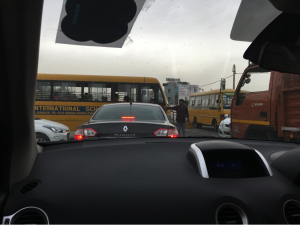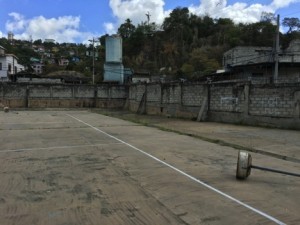
Student transport presents huge safety challenges in India. Millions of students are served by either government or privately operated school buses. However, parents often opt for private transport in unsafe minivans with little if any training and no background checks for drivers. The potential for mass casualty accidents is significant due to the heavy traffic in urban centers. Here a private citizen is attempting to clear a traffic jam which was blocking the route for dozens of school buses and hundreds of motorists.
School Safety and Security in India
Like the U.S., India is a place of many contrasts when it comes to school safety. I recently conducted site visits of a number of schools in the New Delhi region as part of an initiative by an NGO to help improve school safety, security and emergency preparedness throughout the massive country. In one school, I noted buckets of sand that were still in use to use in the event of a fire (though the school now also has fire extinguishers). In the same school, I observed student supervision practices that are superior to those I have observed in most of the U.S. public, charter, faith-based, and independent schools I have assessed. The nation’s many government and privately operated schools face many of the same challenges that U.S. schools do along with others that are quite different.
Security for India’s Massive Educational System
I still find it hard to comprehend that for every one of the more than one million K12 students served by the massive New York City School System, there is an entire school full of children in India. With a mortality rate for children age five and under that is double that of Vietnam, an adult literacy rate that is nearly thirty percent below that of Trinidad-Tobago and a per capita income level well below that of the Philippines, Indian educators face many challenges even when compared to many other developing nations. Children in India are at much greater risk of victimization and accidental death than is the case in the U.S. Seeing children of kindergarten age begging for money amidst a sea of cars during night-time rush hour traffic is heartbreaking.
School Violence and Terrorism Risks
India has significant violence issues as well. For example, parents in India have a considerable and apparently well-grounded fear abduction of their children. There is a particularly significant issue with school girls being abducted, repeatedly gang-raped and held for ransom. We were advised that many of these victims end up being murdered as was the case with a student who was kidnapped, repeatedly raped and murdered by some of her classmates recently. Terrorism also has a significant impact. In the aftermath of the horrific terrorist attacks in Mumbai and other locations, guests at upscale urban hotels and visitors to shopping malls can expect to have their vehicle searched before they pass through a walk-through metal detector and have their hand carry items checked by security X-ray equipment and/or hand searched.
Opportunities for Improvement in School Safety in India
But all is not gloom and doom in India. I saw evidence of dedicated educators doing their part to lift up the nation’s youth. School attendance rates have risen markedly in recent years as well. Just as I have been the case in my visits to schools in other developing nations, I was deeply touched and honored to meet school teachers who though far from wealthy, scrape up money to buy food, school supplies, and other things for their children. As in some of the poorest neighborhoods in America, I have been blessed to witness selfless acts of compassion by those who rise to the challenge of improving the lives of India’s 229 million K12 students.

